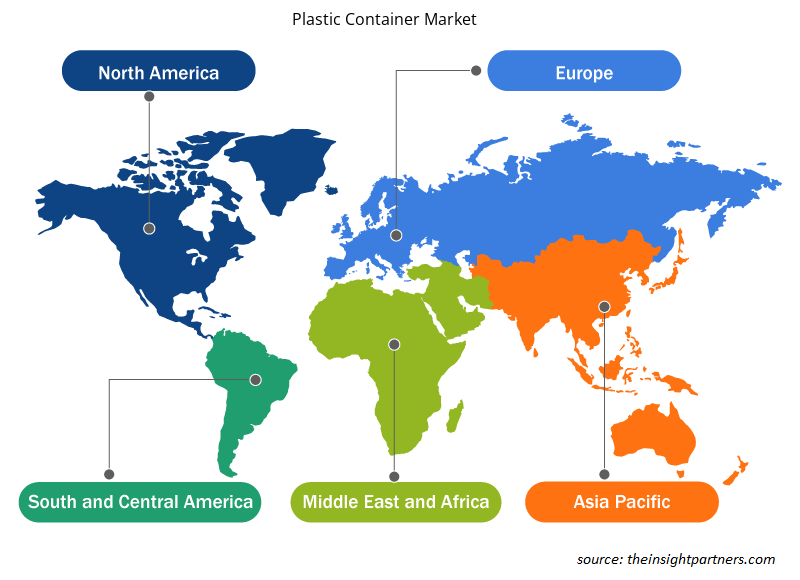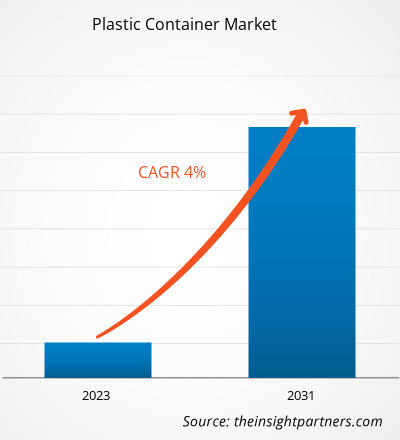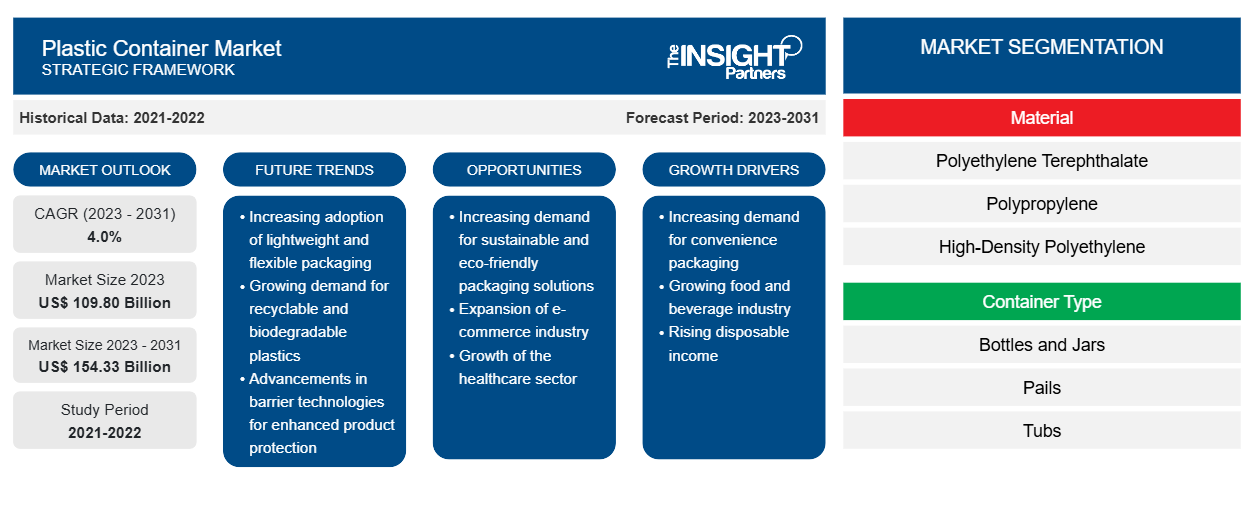塑料容器市场规模预计将从 2023 年的 1098 亿美元增至 2031 年的 1543.3 亿美元。预计 2023-2031 年市场复合年增长率为 4.0%。食品、饮料和化妆品等终端行业的需求不断增长,可能仍是塑料容器市场的主要趋势。
塑料容器市场分析
塑料容器用途广泛,有各种尺寸、形状和设计。它们被广泛用于各种应用,包括食品储存、运输、整理家居用品和包装工业品。塑料容器的灵活性使其成为满足各种需求的热门选择,推动了多个行业的需求。此外,塑料容器具有有效的气密性和防潮性,使其成为新鲜食品包装的理想选择,可保持食品新鲜度。除了这些品质之外,它们的易密封机制对于维护、防止变质和保持卫生至关重要。此外,塑料容器为消费者提供了一种经济高效的替代其他包装材料(如金属包装)的方法。塑料容器重量轻,有助于降低运输成本,使其成为最终用户的理想选择。因此,他们通常更喜欢用塑料容器来包装商品和产品,这增加了家庭和食品行业对塑料食品储存容器的需求。
塑料容器市场概况
个人护理和化妆品制造商通常需要独特且美观的包装材料来吸引消费者。塑料容器可以模制成各种形状、尺寸和设计,这有助于制造商生产美观且独特的包装。在个人护理和化妆品行业中,不同形状和尺寸的塑料包装至关重要,因为产品展示和品牌推广非常重要。
定制此报告以满足您的需求
您可以免费定制任何报告,包括本报告的部分内容、国家级分析、Excel 数据包,以及为初创企业和大学提供优惠和折扣
- 获取此报告的关键市场趋势。这个免费样品将包括数据分析,从市场趋势到估计和预测。
塑料容器市场的驱动因素和机遇
饮料行业需求激增推动塑料容器市场增长
塑料容器是一种轻质且耐用的包装解决方案,是运输饮料的理想选择,有助于降低运输成本并最大限度地降低运输过程中破损的风险。这确保了产品在交付前的完整性。此外,塑料容器正在鼓励创新的包装设计。塑料容器制造商使用不同的形状、颜色和标签来提高产品的视觉吸引力。在竞争激烈的饮料行业中,在商店货架上脱颖而出并吸引客户非常重要。此外,塑料容器通常由可回收材料制成,各种最终用户通过将再生塑料用于产品包装来促进可持续性。人们越来越意识到微塑料对环境和人类健康的负面影响,这促使饮料制造商采用环保包装解决方案。eco-friendly packaging solutions.
电子商务行业蓬勃发展
包装材料的效率和安全性对于电子商务企业至关重要。消费者依靠在线平台购买各种产品,制造商和零售商需要足够的包装来存储、保护和运送这些产品。网上购物的便利性促进了电子商务的发展,这是塑料容器需求不断增长的重要驱动力。塑料容器用途广泛、经久耐用,已成为确保产品安全运输的流行包装材料。塑料容器重量轻、尺寸和形状各异,有助于优化运输和存储空间。这有助于企业降低运输成本,并有助于有效利用空间。
塑料容器市场报告细分分析
有助于塑料容器市场分析的关键部分是材料、容器类型和最终用途。
- 根据材料,市场细分为聚对苯二甲酸乙二醇酯、聚丙烯、高密度聚乙烯、低密度聚乙烯等。聚对苯二甲酸乙二醇酯部分在 2023 年占据了更大的市场份额。
- 就容器类型而言,塑料容器市场分为瓶罐、桶、桶、杯碗等。2023 年,瓶罐部分占据了更大的市场份额。
- 根据最终用途,市场分为饮料、食品、药品、个人护理和化妆品等。饮料部门在 2023 年占据了更大的市场份额。
塑料容器市场份额按地区分析
塑料容器市场报告的地理范围主要分为五个地区:北美、亚太、欧洲、中东和非洲、南美和中美。
亚太地区人口快速增长和城市化导致包装食品和饮料消费增加。因此,对包装材料的需求也随之增加,塑料容器因其便利性和价格实惠而成为热门选择。此外,许多亚太国家的经济增长提高了可支配收入,导致消费者偏好发生变化。消费者现在更倾向于购买方便食品和饮料。可重新密封的盖子和轻量包装等便利因素推动了塑料容器市场的发展。此外,亚太地区的电子商务行业正在蓬勃发展,这在很大程度上依赖于高效的包装解决方案。塑料容器,如饮料用 PET 瓶和各种食品容器,非常适合在线零售,因为它们耐用、轻便,并降低了运输过程中产品损坏的风险。
塑料容器市场区域洞察
Insight Partners 的分析师已详细解释了预测期内影响塑料容器市场的区域趋势和因素。本节还讨论了北美、欧洲、亚太地区、中东和非洲以及南美和中美洲的塑料容器市场细分和地理位置。

- 获取塑料容器市场的区域特定数据
塑料容器市场报告范围
| 报告属性 | 细节 |
|---|---|
| 2023 年的市场规模 | 1098亿美元 |
| 2031 年市场规模 | 1543.3亿美元 |
| 全球复合年增长率(2023 - 2031) | 4.0% |
| 史料 | 2021-2022 |
| 预测期 | 2023-2031 |
| 涵盖的领域 | 按材质
|
| 覆盖地区和国家 | 北美
|
| 市场领导者和主要公司简介 |
|
塑料容器市场参与者密度:了解其对业务动态的影响
塑料容器市场正在快速增长,这得益于终端用户需求的不断增长,而这些需求又源于消费者偏好的不断变化、技术进步以及对产品优势的认识不断提高等因素。随着需求的增加,企业正在扩大其产品范围,进行创新以满足消费者的需求,并利用新兴趋势,从而进一步推动市场增长。
市场参与者密度是指在特定市场或行业内运营的企业或公司的分布情况。它表明在给定市场空间中,相对于其规模或总市场价值,有多少竞争对手(市场参与者)存在。
在塑料容器市场运营的主要公司有:
- 安姆科公司
- Sonoco 产品公司
- 贝瑞全球公司
- Plastipak 控股公司
- ALPLA Werke Alwin Lehner GmbH and Co KG
- 格雷厄姆包装公司
免责声明:上面列出的公司没有按照任何特定顺序排列。

- 了解塑料容器市场的主要参与者概况
塑料容器市场新闻及最新发展
塑料容器市场通过收集一手和二手研究后的定性和定量数据进行评估,其中包括重要的公司出版物、协会数据和数据库。以下是塑料容器市场的发展和战略列表:
- Berry Global 的技术和制造技能在危险液体包装方面取得了重大突破。该公司现已推出首批 20 升和 25 升容器,其中含有 35% 的再生材料,这些容器已获得联合国批准,可用于运输联合国评估中的六种液体模型中的五种危险货物。除了现有的联合国对水的批准外,新容器还获得了润湿溶液、乙酸、白酒精和正丁酯乙酸酯的批准。将这些新容器引入该公司广受欢迎的 Optimum 系列将支持公司实现可持续发展目标并满足消费者对更可持续包装解决方案的需求。它还将帮助企业遵守即将出台的有关包装中所需最低再生材料量的立法。(来源:Berry Global Inc,新闻稿,2023 年)
塑料容器市场报告覆盖范围和交付成果
“塑料容器市场规模和预测(2021-2031)”报告对以下领域进行了详细的市场分析:
- 范围内涵盖的所有主要细分市场的全球、区域和国家层面的市场规模和预测
- 市场动态,如驱动因素、限制因素和关键机遇
- 未来主要趋势
- 详细的波特五力分析和 SWOT 分析
- 全球和区域市场分析涵盖关键市场趋势、主要参与者、法规和最新市场发展
- 行业格局和竞争分析,涵盖市场集中度、热点图分析、知名参与者和最新发展
- 详细的公司简介
- 历史分析(2 年)、基准年、预测(7 年)及复合年增长率
- PEST和SWOT分析
- 市场规模、价值/数量 - 全球、区域、国家
- 行业和竞争格局
- Excel 数据集
近期报告
相关报告
客户评价
购买理由
- 明智的决策
- 了解市场动态
- 竞争分析
- 客户洞察
- 市场预测
- 风险规避
- 战略规划
- 投资论证
- 识别新兴市场
- 优化营销策略
- 提升运营效率
- 顺应监管趋势





















 获取免费样品 - 塑料容器市场
获取免费样品 - 塑料容器市场